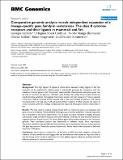Comparative genomic analysis reveals independent expansion of a lineage-specific gene family in vertebrates: The class II cytokine receptors and their ligands in mammals and fish
Author(s)
Lutfalla, Georges; Roest Crollius, Hugues; Stange-Thomann, Nicole; Jaillon, Olivier; Mogensen, Knud; Monneron, Daniele; ... Show more Show less
Download1471-2164-4-29.pdf (369.2Kb)
PUBLISHER_CC
Publisher with Creative Commons License
Creative Commons Attribution
Terms of use
Metadata
Show full item recordAbstract
Background: The high degree of sequence conservation between coding regions in fish and mammals can be exploited to identify genes in mammalian genomes by comparison with the sequence of similar genes in fish. Conversely, experimentally characterized mammalian genes may be used to annotate fish genomes. However, gene families that escape this principle include the rapidly diverging cytokines that regulate the immune system, and their receptors. A classic example is the class II helical cytokines (HCII) including type I, type II and lambda interferons, IL10 related cytokines (IL10, IL19, IL20, IL22, IL24 and IL26) and their receptors (HCRII). Despite the report of a near complete pufferfish (Takifugu rubripes) genome sequence, these genes remain undescribed in fish. Results: We have used an original strategy based both on conserved amino acid sequence and gene structure to identify HCII and HCRII in the genome of another pufferfish, Tetraodon nigroviridis that is amenable to laboratory experiments. The 15 genes that were identified are highly divergent and include a single interferon molecule, three IL10 related cytokines and their potential receptors together with two Tissue Factor (TF). Some of these genes form tandem clusters on the Tetraodon genome. Their expression pattern was determined in different tissues. Most importantly, Tetraodon interferon was identified and we show that the recombinant protein can induce antiviral MX gene expression in Tetraodon primary kidney cells. Similar results were obtained in Zebrafish which has 7 MX genes. Conclusion: We propose a scheme for the evolution of HCII and their receptors during the radiation of bony vertebrates and suggest that the diversification that played an important role in the fine-tuning of the ancestral mechanism for host defense against infections probably followed different pathways in amniotes and fish.
Date issued
2003-07Department
Whitehead Institute for Biomedical ResearchJournal
BMC Genomics
Publisher
BioMed Central Ltd
Citation
BMC Genomics. 2003 Jul 17;4(1):29
Version: Final published version
ISSN
1471-2164